Samsung Galaxy Nexus & Ice Cream Sandwich Review
by Brian Klug & Anand Lal Shimpi on January 18, 2012 1:34 PM ESTThe Browser
The improvements to the Android web browser are some of the most noticeable in Ice Cream Sandwich. Browser performance both in JavaScript rendering and web page scrolling is worlds better than in Gingerbread. We've already explained why scrolling is smoother (full OpenGL ES render path), while the js performance improvements come courtesy of a newer V8 rendering engine in ICS.
The browser in 4.x also includes essentially everything that made the browser in 3.x smooth as well. As opposed to the Android 2.x browser's immediate rendering system - which would redraw the page in its entirety as you zoomed and panned around and seem choppy as a result - Android 3.x/4.x now render tiles into a backing store for webpages. This is the same system that iOS, webOS, and Samsung's custom browsers use, and as a result panning and translating around is now just as smooth as it is in those platforms. To be totally honest, this is probably one of the single largest and most welcome improvements over Android 2.x because of how dramatic the difference is.
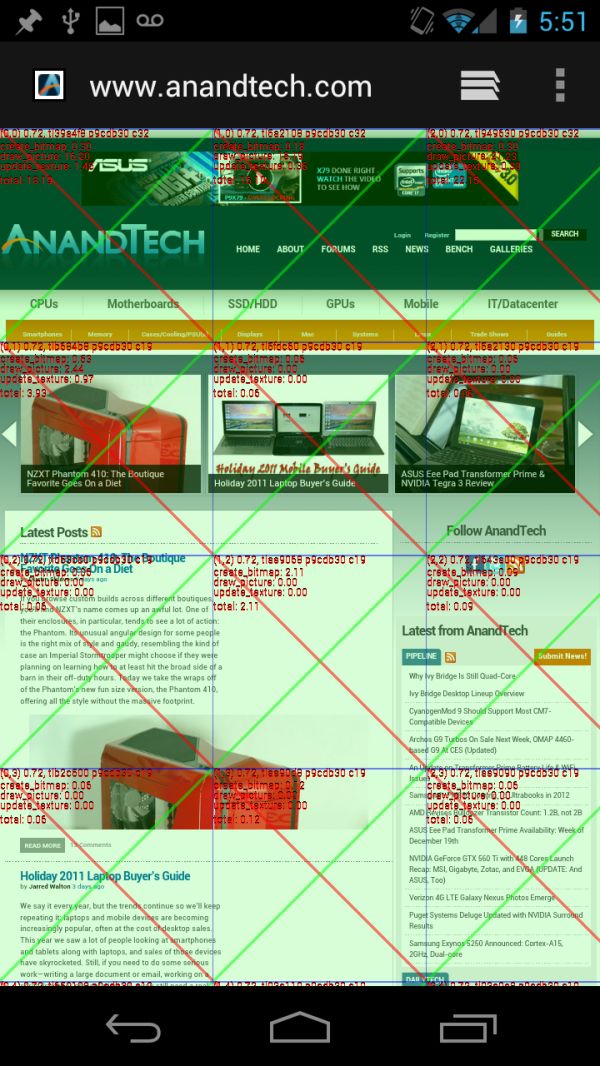
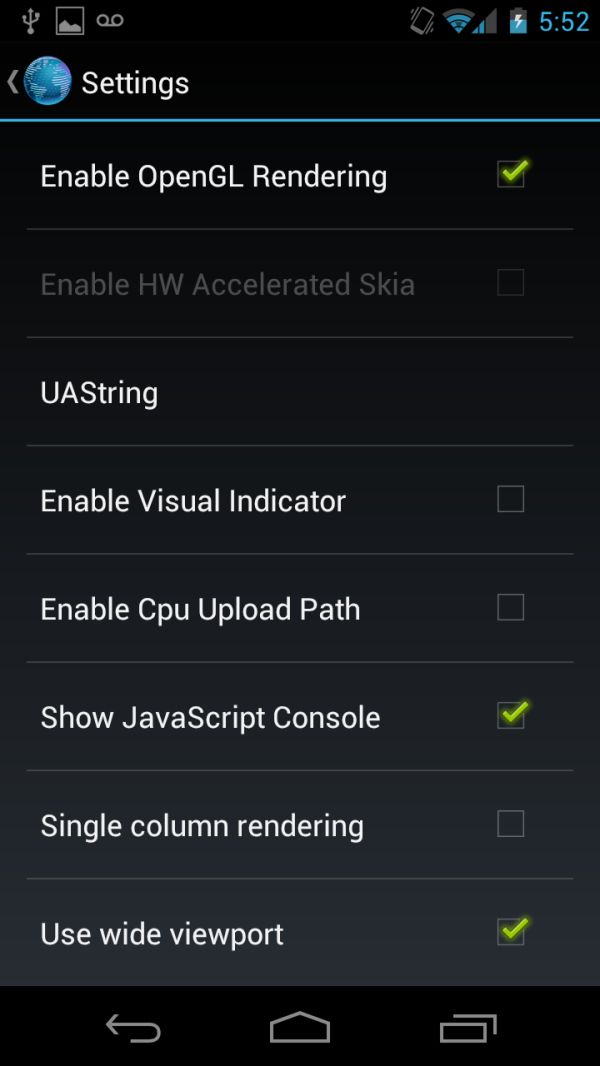
Android 4.0 browser with visual indicator enabled (left), debug settings (right)
In Android 4.0 you can actually go inside the debug settings for the browser (enter about:debug into the address bar, enter, then a new settings pane emerges) and enable or disable OpenGL assisted rendering for the browser. With it off, it feels just like 2.x's choppy stock browser, and with it on, it feels buttery smooth like 3.x. The difference is beyond dramatic. This is actually a feature that was present in Android 3.x as well.
A look at SunSpider and Browsermark performance tells us all we need to know about how the JavaScript V8 engine performance has changed under ICS:
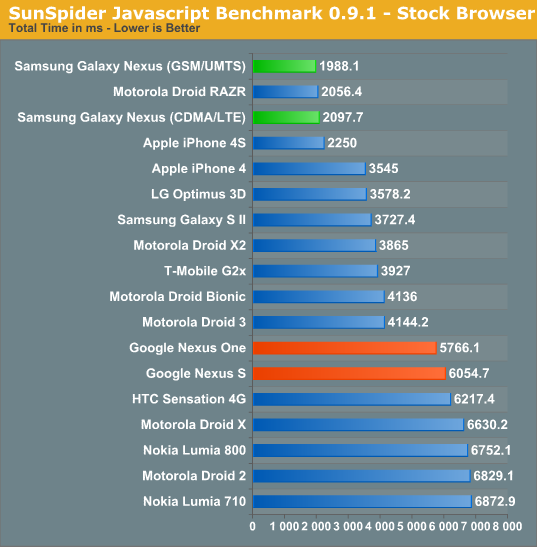
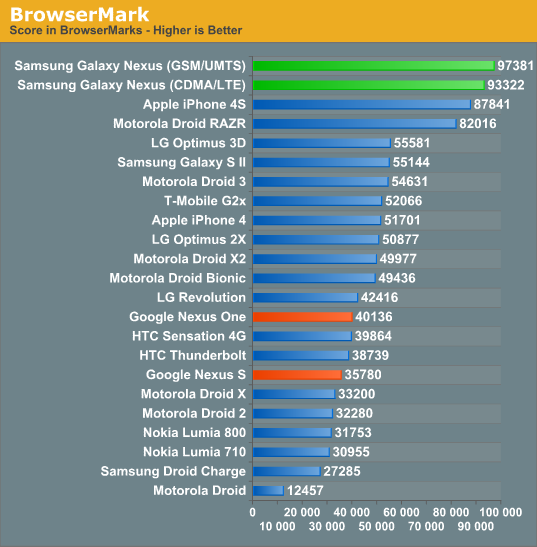
While companies like Motorola and Samsung backported parts of the Honeycomb browser to their own Gingerbread browsers, the stock Gingerbread browser needed work. ICS modernizes the Android web browser and finally removes the need for third party customizations, at least from a performance standpoint.
| Gingerbread vs. Ice Cream Sandwich | ||||
| Gingerbread | Ice Cream Sandwich | |||
| Browser |
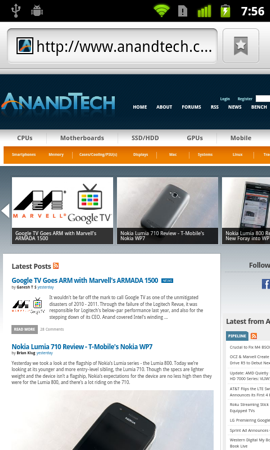 |
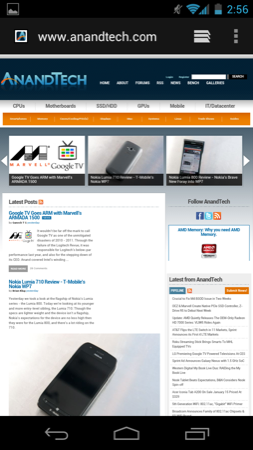 |
||
The ICS browser is still WebKit based and uses a much newer version of WebKit than what you'll find in Android 2.3.6. Compared to the latest Honeycomb browser however there's not all that much difference in version number. The ICS browser does still use an older version of WebKit than Mobile Safari in iOS 5.0.1:
| User Agent String Comparison | |||||
| Device | OS | WebKit Version | UA String | ||
| Apple iPhone 4S | iOS 5.0.1 | 534.46 | Mozilla/5.0 (iPhone; CPU iPhone OS 5_0_1 like Mac OS X) AppleWebKit/534.46 (KHTML, like Gecko) Version/5.1 Mobile/9A405 Safari/7534.48.3 | ||
| Samsung Galaxy Nexus | Android 4.0.2 | 534.30 |
Mozilla/5.0 (Linux; U; Android 4.0.2; en-us; Galaxy Nexus Build/ICL53F) AppleWebKit/534.30 (KHTML, like Gecko) Version/4.0 Mobile Safari/534.30 |
||
| ASUS TF Prime | Android 3.2.1 | 534.13 |
Mozilla/5.0 (Linux; U; Android 3.2.1; en-us; Transformer Prime TF201 Build HTK75) AppleWebKit/534.13 (KHTML, like Gecko) Version/4.0 Safari/534.13 |
||
| Google Nexus One | Android 2.3.6 | 533.1 | Mozilla/5.0 (Linux; U; Android 2.3.6; en-us; Nexus One Build/GRK39F) AppleWebKit/533.1 (KHTML, like Gecko) Version/4.0 Mobile Safari/533.1 | ||
HTML5 compatibility is fairly similar to Honeycomb, although a significant improvement compared to Gingerbread. If you haven't had any experience with Honeycomb tablets, the ICS browser will feel like like brand new technology.
| The HTML5 Test | ||||||||
| Test | Apple iPhone 4S | Samsung Galaxy Nexus | Google Nexus One | ASUS Eee Pad Transformer | ASUS Eee Pad Transformer Prime | |||
| OS | iOS 5.0.1 | Android 4.0.2 | Android 2.3.6 | Android 3.2.1 | Android 3.2.1 | |||
| WebKit Version | 534.46 | 534.30 | 533.1 | 534.13 | 534.13 | |||
| Total Score | 305 (and 9 bonus points) | 256 (and 3 bonus points) | 182 (and 1 bonus point) | 222 (and 3 bonus points) | 233 (and 3 bonus points) | |||
| Parsing rules | 11 (2 bonus points) | 11 (2 bonus points) | 1/11 | 11 (2 bonus points) | 11 (2 bonus points) | |||
| Canvas | 20 | 20 | 20 | 20 | 20 | |||
| Video | 21/31 (4 bonus points) | 21/31 | 21/31 | 21/31 | 21/31 | |||
| Audio | 20 (3 bonus points) | 20 (1 bonus point) | 20 (1 bonus point) | 20 (1 bonus point) | 20 (1 bonus point) | |||
| Elements | 22/29 | 23/29 | 13/29 | 20/29 | 20/29 | |||
| Forms | 77/100 | 57/100 | 33/100 | 54/100 | 54/100 | |||
| User Interaction | 17/36 | 17/36 | 0/36 |
0/36 |
0/36 | |||
| History and navigation | 5 | 5 | 5 | 0/5 | 0/5 | |||
| Microdata | 0/15 | 0/15 | 0/15 | 0/15 | 0/15 | |||
| Web applications | 15/20 | 15/20 | 19/20 | 15/20 | 15/20 | |||
| Security | 5/10 | 5/10 | 5/10 | 5/10 | 5/10 | |||
| Geolocation | 15 | 15 | 15 | 15 | 15 | |||
| WebGL | 9/25 | 9/25 | 0/25 | 0/25 | 9/25 | |||
| Communication | 32/36 | 12/36 | 9/36 | 10/36 | 12/36 | |||
| Files | 0/20 | 10/20 | 0/20 | 10/20 | 10/20 | |||
| Storage | 15/20 | 15/20 | 15/20 | 15/20 | 15/20 | |||
| Workers | 15 | 0/15 | 0/15 | 0/15 | 0/15 | |||
| Local multimedia | 0/20 | 0/20 | 0/20 | 0/20 | 0/20 | |||
| Notifications | 0/10 | 0/10 | 0/10 | 0/10 | 0/10 | |||
| Other | 6/8 | 6/8 | 6/8 | 6/8 | 6/8 | |||
Performance and compatibility are obvious improvements, however there's much more to the ICS browser. For starters it implements tabbed browsing, a feature that has been available on Honeycomb but not in Gingerbread. Given the small screen size, tabs aren't immediately visible but are instead switched between after hitting the tabs button. The process makes sense and thanks to GPU accelerated drawing, scrolling through tabs is extremely smooth.
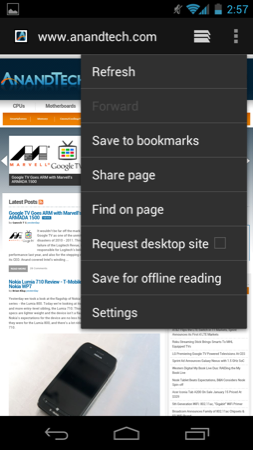
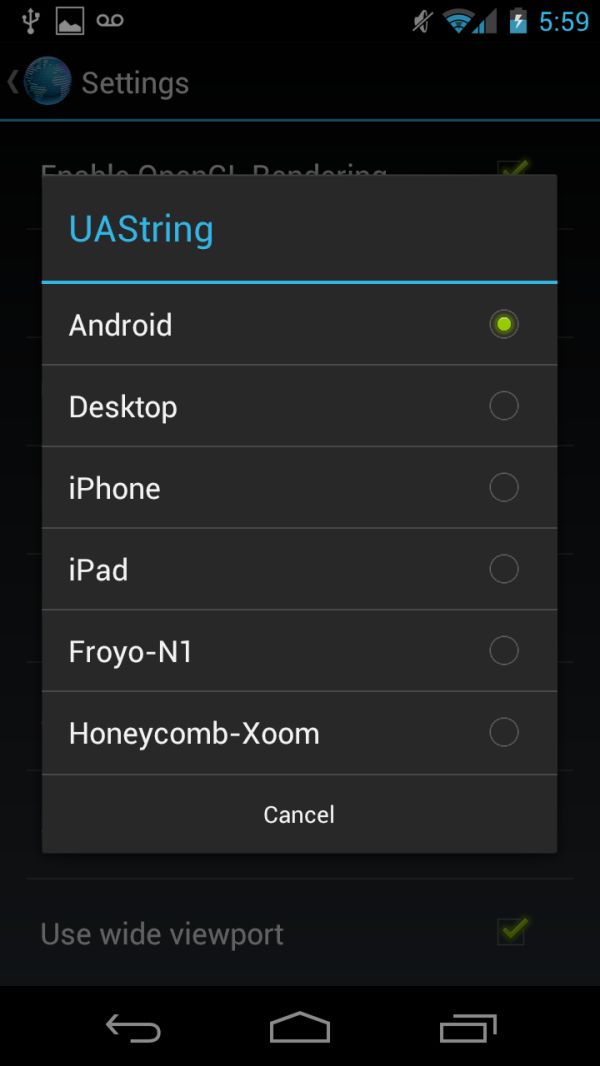
The normal desktop UA switcher (left), More options under developer settings (right)
Google added quick user agent switching to ask for desktop versions of websites vs. mobile by default through a checkbox under settings. Enabling the option changes the browser's UA string from representing itself as a mobile Safari browser to Chrome 11. There's also a menu inside debug settings to change your user agent (UAString) to look like the desktop, iPhone, iPad, Nexus One with Froyo, or a Xoom with Honeycomb.
| User Agent String Comparison | |||||
| Device | UA String | ||||
| Default |
Mozilla/5.0 (Linux; U; Android 4.0.2; en-us; Galaxy Nexus Build/ICL53F) AppleWebKit/534.30 (KHTML, like Gecko) Version/4.0 Mobile Safari/534.30 |
||||
| Desktop |
Mozilla/5.0 (X11; Linux x86_64) AppleWebKit 534.24 (KHTML, like Gecko) Chrome/11.0.696.34 Safari/534.24 |
||||
Prior to ICS, the browser was a serious limitation of the Android platform on smartphones - it was choppy, and something OEMs continually replaced with their own (sometimes worse, sometimes better) browser. Granted you could always download and replace the browser with one of your own choosing, but for the mainstream user the Gingerbread browser was a problem. In ICS the browser is a blessing to use. It's very fast, smooth and compatible. We've had no problems using the Honeycomb browser and the same can be thankfully said about the evolution of it in ICS.










185 Comments
View All Comments
HooDooMagic - Friday, January 20, 2012 - link
I think it's already been mentioned that 4.03 fixed the task switcher lag. I have alpha ICS 4.03 roms running on a Nexus One, Nook Color and Samsung Galaxy Tab 10.1 and everything runs very smoothly on all 3 devices. Even the very underpowered Nook has surprisingly little lag and stutter when using the task switcher and transitioning between screens/app drawer etc.Chloiber - Wednesday, January 18, 2012 - link
The Galaxy Nexus is a very nice phone indeed, but there are just some things that I don't like about it. As mentioned in the review, the GPU is not the best, which is actually the main reason I won't buy the phone. I buy smartphones which should last about 2 years. Buying one with a GPU from the beginning of last year is just not good enough. As Anand mentions: better wait for Q2, maybe Q3. At the moment, the GN is certainly the best phone (in my opinion) money can buy, but it's not the right moment to buy an android phone.The review is very late indeed...but very thorough - thank you!
One question remains: are microSD slots a thing of the past? Google mentioned that there is a good reason why they didn't include one (slow speeds for apps). But I still think that's a very bad reason not to include a slot. While it is true, that the mSD cards are pretty slow compared to internal storage, there is just no way in hell I'm gonna pay 100$+ for 16GB of additional internal NAND. Additionally, you don't need high speeds for music, pictures and movies (the main reason to get an SD card).
I hope for a phone in Q2/Q3 with a) better SoC, b) an SD card slot and c) a 720p IPS or SAMOLED+ screen.
humancyborg - Wednesday, January 18, 2012 - link
I agree. The GPU is a terrible oversight on this phone, particularly considering the inclusion (finally) of OpenGL rendering throughout Android.With the 4S GPU being 3-4x faster it's tough to see how this phone is going to stand the test of time. Presumably the iPad3 and next iPhone will be packing an even more powerful SoC and GPU.
This is one of the main reasons that I think Apple is in a great position going forward with regards to hardware. With the exception of Samsung, everyone else is relying on TI, Qualcomm, Intel, etc to make the right decisions with regards to CPU/GPU etc combination and clearly those chip makers do not always have the best insight with regards to product pipeline or requirements.
A retina display-ish version of the iPad is going to take a GPU far beyond anything the current SoC guys are manufacturing.
tipoo - Wednesday, January 18, 2012 - link
The next generation of PowerVR SGX graphics chips are supposedly 20x as powerful as the current ones. I'm guessing Apple will still be using the dual core variant of the 6** series. That's good, if the 4x screen resolution rumours are true.Yeesh, Android devices still haven't caught up to the old GPU now a new one is around the corner. Nvidia is stuck with their own GPU's of course, but TI or Samsung should switch to PowerVR if this performance domination continues.
trob6969 - Wednesday, January 18, 2012 - link
What performance domination?! Android phones are easily the most powerful on the market!Greg512 - Wednesday, January 18, 2012 - link
Not when it comes to GPU power. The iPhone 4S has a GPU 3-4 times as powerful as the one in the Nexus. Android phones do tend to have higher clocked processors, however, so they do have a healthy advantage on that front. Android phones also have more RAM, though many would debate that iOS is memory efficient, negating the hardware advantage.KoolAidMan1 - Wednesday, January 18, 2012 - link
You're kidding, right? The Tegra 3 is slower than the eight month old A5. Everything in Android world is playing catch-up with old parts, which is odd given that they have a more frequent upgrade cycle. Problem is that they've been behind since the beginning.doobydoo - Thursday, January 19, 2012 - link
trob6969 - the leading Android phones have CPU's which are largely comparable to the CPU in the iPhone 4S - in some cases they even boast up to ~10% extra performance (as a result of, in some cases, 50% higher clock speed), but only in CPU limited tasks, and that <10% is barely noticeable.Graphically, the GPU in the Nexus Prime is far slower than even the Samsung Galaxy S2 - using an older GPU which is up to 3x slower than the GPU in the iPhone 4S. The GPU in the SG2 (the fastest Android GPU) is also far slower than the iPhone 4S (as the benchmarks in this review show)
Because iOS is hardware accelerated (and tightly intertwined with the iPhone), the performance of the iPhone 4S and iOS is far superior to any Android phone out at this moment in time.
zorxd - Thursday, January 19, 2012 - link
uh?50% faster clock speed gives you 50% more performance in CPU limited tasks. Don't forget that it's the same architecture (Cortex A9).
I hope you are not making that 10% claim based on javascript bencmarks. They are browser benchmarks more than CPU benchmarks.
Zoomer - Thursday, January 19, 2012 - link
Not really, the A9 ISA have many different architecture implantations. TI does their own, Apple probably did their own, and I believe nVidia has their own too.